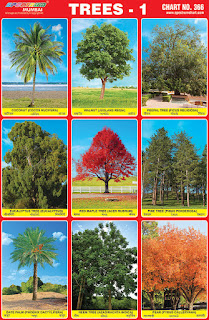 |
| Trees Chart |
Spectrum Chart - 366 : Trees 1
1. Coconut Tree (Cocos Nucifera) – The
coconut tree (Cocos nucifera) is a member of the family Arecaceae
(palm family) and the only accepted species in the genus Cocos. Cocos
nucifera is a large palm, growing up to 30 m tall, with pinnate leaves
4–6 m long and pinnae 60–90 cm long.
2. Ashoka Tree (Saraca Asoca) - Ashoka
tree is a plant belonging to the Caesalpinioideae subfamily of the
legume family. It is an important tree in the cultural traditions of
the Indian subcontinent. The ashoka is a rain-forest tree. The ashoka
tree is prized for its beautiful foliage and fragrant flowers. It is
a handsome, small, erect evergreen tree, with deep green leaves
growing in dense clusters.
3. Peepal Tree (Ficus Religiosa) –
Peepal tree (Ficus religiosa) is a species of fig native to the
Indian subcontinent and south-west China. Peepal tree is a large dry
season-deciduous or semi-evergreen tree up to 30 m tall and with a
trunk diameter of up to 3 m. The leaves are cordate in shape with a
distinctive extended drip tip. Tree is considered sacred by the
followers of Hinduism, Jainism and Buddhism.
4. Eucalyptus Tree (Eucalyptus) –
Eucalyptus is a diverse genus of flowering trees in the myrtle
family, Myrtaceae. There are more than 700 species of eucalyptus and
most are native to Australia. All eucalyptus are evergreen, but some
tropical species lose their leaves at the end of the dry season. As
in other members of the myrtle family, eucalyptus leaves are covered
with oil glands. Eucalyptus is the most common short fibre source for
pulpwood to make pulp.
5. Red Maple Tree (Acer Rubrum) - Red
maple tree (Acer rubrum) is one of the most common and widespread
deciduous trees of eastern and central North America. It is
recognised as the most common species of tree in America. It is a
medium to large sized tree, reaching heights of 18 to 27 m. The leaves
are usually 9 to 11 cm long on a full grown tree.
6. Pine Tree (Pinus Ponderosa) – Pine
tree (Pinus ponderosa) is a very large pine tree species of variable
habitat native to the western United States and Canada. It is a large
coniferous pine tree. This tree is grown as an ornamental plant in
parks and large gardens.
7. Talipot Palm Tree (Corypha
Umbraculifera) - Corypha umbraculifera, the talipot palm, is a
species of palm native to eastern and southern India and Sri Lanka.
It is a flowering plant with the largest inflorescence in the world.
It is one of the largest palms with individual specimens having
reached heights of up to 25 m with stems up to 1.3 m in diameter. It is
a fan palm with large, palmate leaves up to 5 m in diameter, with a
petiole up to 4 m and up to 130 leaflets.
8. Neem Tree (Azadirachta Indica) – Neem
tree (Azadirachta indica) is a tree in the mahogany family Meliaceae.
It is native to India and the Indian subcontinent. It is typically
grown in tropical and semi-tropical regions. Its fruits and seeds are
the source of neem oil. Neem is a fast-growing tree that can reach a
height of 15–20 m. It is evergreen, but in severe drought it may
shed most or nearly all of its leaves. The branches are wide and
spreading.
9. Callery Pear Tree (Pyrus Calleryana) -
Callery pear tree (Pyrus calleryana) is a species of pear native to
China and Vietnam in the family Rosaceae. It is adeciduous tree
growing to 5 to 8 m tall, often with a conic to rounded crown. The
leaves are oval, 4 to 8 cm long, glossy dark green above and slightly
paler below. Pear wood is among the finest-textured of all
fruitwoods. It is prized for making woodwind instruments and pear
veneer is used in fine furniture.

No comments:
Post a Comment